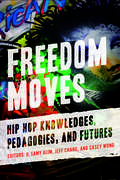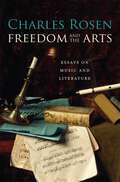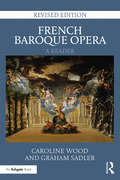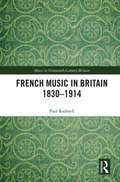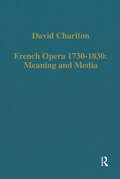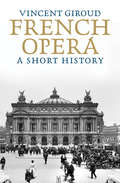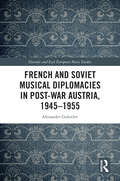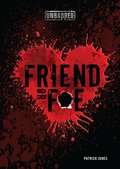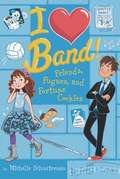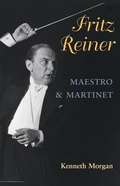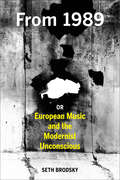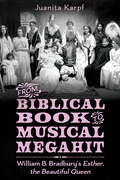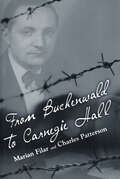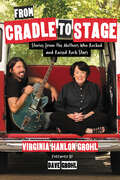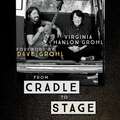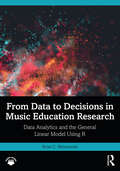- Table View
- List View
Freedom Moves: Hip Hop Knowledges, Pedagogies, and Futures (California Series in Hip Hop Studies #3)
by H. Samy Alim, Jeff Chang, and Casey Philip WongThis expansive collection sets the stage for the next generation of Hip Hop scholarship as we approach the fiftieth anniversary of the movement’s origins. Celebrating 50 years of Hip Hop cultural history, Freedom Moves travels across generations and beyond borders to understand Hip Hop’s transformative power as one of the most important arts movements of our time. This book gathers critically acclaimed scholars, artists, activists, and youth organizers in a wide-ranging exploration of Hip Hop as a musical movement, a powerful catalyst for activism, and a culture that offers us new ways of thinking and doing freedom. Rooting Hip Hop in Black freedom culture, this state-of-the-art collection presents a globally diverse group of Black, Indigenous, Latinx, Asian American, Arab, European, North African, and South Asian artists, activists, and thinkers. The "knowledges" cultivated by Hip Hop and spoken word communities represent emerging ways of being in the world. Freedom Moves examines how educators, artists, and activists use these knowledges to inform and expand how we understand our communities, our histories, and our futures.
Freedom and the Arts: Essays on Music and Literature
by Charles RosenIs there a moment in history when a work receives its ideal interpretation? Or is negotiation always required to preserve the past and accommodate the present? The freedom of interpretation, Charles Rosen suggests in these sparkling explorations of music and literature, exists in a delicate balance with fidelity to the identity of the original work. Rosen cautions us to avoid doctrinaire extremes when approaching art of the past. To understand Shakespeare only as an Elizabethan or Jacobean theatergoer would understand him, or to modernize his plays with no sense of what they bring from his age, deforms the work, making it less ambiguous and inherently less interesting. For a work to remain alive, it must change character over time while preserving a valid witness to its earliest state. When twentieth-century scholars transformed Mozart's bland, idealized nineteenth-century image into that of a modern revolutionary expressionist, they paradoxically restored the reputation he had among his eighteenth-century contemporaries. Mozart became once again a complex innovator, challenging to perform and to understand. Drawing on a variety of critical methods, Rosen maintains that listening or reading with intensity-for pleasure-is the one activity indispensable for full appreciation. It allows us to experience multiple possibilities in literature and music, and to avoid recognizing only the revolutionary elements of artistic production. By reviving the sense that works of art have intrinsic merits that bring pleasure, we justify their continuing existence.
French Baroque Opera: Revised Edition
by Caroline Wood Graham SadlerFrom the outset, French opera generated an enormous diversity of literature, familiarity with which greatly enhances our understanding of this unique art form. Yet relatively little of that literature is available in English, despite an upsurge of interest in the Lully-Rameau period during the past two decades. This book presents a wide-ranging and informative picture of the organization and evolution of French Baroque opera, its aims and aspirations, its strengths and weaknesses. Drawing on official documents, theoretical writings, letters, diaries, dictionary entries, contemporary reviews and commentaries, it provides an often entertaining insight into Lully’s once-proud Royal Academy of Music and the colourful characters who surrounded it. The translated passages are set in context, and readers are directed to further scholarly and critical writings in English. Readers will find this new, updated edition easier to use with its revised and expanded translations, supplementary explanatory content and new illustrations.
French Music Since Berlioz
by Caroline PotterFrench Music Since Berlioz explores key developments in French classical music during the nineteenth and twentieth centuries. This volume draws on the expertise of a range of French music scholars who provide their own perspectives on particular aspects of the subject. D dre Donnellon's introduction discusses important issues and debates in French classical music of the period, highlights key figures and institutions, and provides a context for the chapters that follow. The first two of these are concerned with opera in the nineteenth and twentieth centuries respectively, addressed by Thomas Cooper for the nineteenth century and Richard Langham Smith for the twentieth. Timothy Jones's chapter follows, which assesses the French contribution to those most Germanic of genres, nineteenth-century chamber music and symphonies. The quintessentially French tradition of the nineteenth-century salon is the subject of James Ross's chapter, while the more sacred setting of Paris's most musically significant churches and the contribution of their organists is the focus of Nigel Simeone's essay. The transition from the nineteenth to the twentieth century is explored by Roy Howat through a detailed look at four leading figures of this time: Faur Chabrier, Debussy and Ravel. Robert Orledge follows with a later group of composers, Satie & Les Six, and examines the role of the media in promoting French music. The 1930s, and in particular the composers associated with Jeune France, are discussed by Deborah Mawer, while Caroline Potter investigates Parisian musical life during the Second World War. The book closes with two chapters that bring us to the present day. Peter O'Hagan surveys the enormous contribution to French music of Pierre Boulez, and Caroline Potter examines trends since 1945. Aimed at teachers and students of French music history, as well as performers and the inquisitive concert- and opera-goer, French Music Since Berlioz is an essential companion for an
French Music and Jazz in Conversation
by Deborah MawerFrench concert music and jazz often enjoyed a special creative exchange across the period 1900-1965. French modernist composers were particularly receptive to early African-American jazz during the interwar years, and American jazz musicians, especially those concerned with modal jazz in the 1950s and early 1960s, exhibited a distinct affinity with French musical impressionism. But despite a general, if contested, interest in the cultural interplay of classical music and jazz, few writers have probed the specific French music-jazz relationship in depth. In this book, Deborah Mawer sets such musical interplay within its historical-cultural and critical-analytical contexts, offering a detailed yet accessible account of both French and American perspectives. Blending intertextuality with more precise borrowing techniques, Mawer presents case studies on the musical interactions of a wide range of composers and performers, including Debussy, Satie, Milhaud, Ravel, Jack Hylton, George Russell, Bill Evans and Dave Brubeck.
French Music in Britain 1830–1914 (Music in Nineteenth-Century Britain)
by Paul J RodmellFrench Music in Britain 1830–1914 investigates the presence, reception and influence of French art music in Britain between 1830 (roughly the arrival of ‘Grand Opera’ and opéra comique in London) and the outbreak of the First World War. Five chronologically ordered chapters investigate key questions such as: * Where and to whom was French music performed in Britain in the nineteenth century? * How was this music received, especially by journal and newspaper critics and other arbiters of taste? * What characteristics and qualities did British audiences associate with French music? * Was the presence and reception of French music in any way influenced by Franco-British political relations, or other aspects of cultural transfer and exchange? * Were British composers influenced by their French contemporaries to any extent and, if so, in what ways? Placed within the wider social and cultural context of Britain’s most ambiguous and beguiling international relationship, this volume demonstrates how French music became an increasingly significant part of the British musician’s repertory and influenced many composers. This is an important resource for musicologists specialising in Nineteenth-Century Music, Music History, and European Music. It is also relevant for scholars and researchers of French Studies and Cultural Studies.
French Opera 1730-1830: Meaning and Media (Variorum Collected Studies)
by David CharltonThe majority of these collected essays date from 1992 onwards, three of them having been specially expanded for this volume. Drawing on recent archival research and new musicological theory, they investigate distinctive qualities in French opera from early opéra comique to early grand opera. ’Media’ is interpreted in terms of both narrative systems and practical theatre resources. One group of essays identifies narrative systems in ’minuet-scenes’, in the diegetic romance, and in special uses of musical motives. Another group concerns the theory and æsthetics of opera, in which uses of metaphor help us interpret audience reception. A third group focuses on orchestral and staging practices, brought together in a new theory of the 'melodrama model’ linking various genres from the 1780s with the world of the 1820s. French opera’s relation with literature and politics is a continuing theme, explored in writings on prison scenes, Ossian, and public-private dramaturgy in grand opera. David Charlton has written widely on French music and opera topics for over 25 years. The selection of his articles presented here focuses on the period 1730-1830 when Paris was a hotbed of influential ideas in music and music theatre, with many of these ideas taken up by foreign composers. This volume assesses the French contribution to the development of Classical and Romantic styles and genres which has hitherto not received the attention it deserves.
French Opera: A Short History
by Vincent GiroudFrench opera is second only to Italian opera in the length, breadth, and diversity of its history. Yet most people, if asked to come up with titles, could mention only a handful of titles--Carmen, Faust, Pelleas et Melisande, Samson et Dalila--a small list for an operatic tradition that began in the seventeenth century and is still very much alive. This book provides a full, single-volume account of opera in France from its origins to the present day. Vincent Giroud looks at the leading composers, from Lully to Messiaen and beyond; at the development of French operatic form and style; at performance, performers, and audience; and at the impact of French opera beyond France's borders. Lovers of opera will find this an ideal companion to their appreciation of the form.
French and Soviet Musical Diplomacies in Post-War Austria, 1945-1955 (Slavonic and East European Music Studies)
by Alexander GolovlevFrench and Soviet Musical Diplomacies in Post-War Austria, 1945-1955 investigates how promoting 'national' music and musicians was used as an important asset by France and the USSR in post-Nazi Austria, covering music’s role in international relations at various levels, within changing power frameworks. Bridging international relations, musical sociology, media studies, and Cold War history, four incisive chapters examine the crossroads of Soviet, French, and Austrian cultural politics and discourse-building, presented in two parts - institutions of musical diplomacy: Soviet and French cultural diplomats in comparison; sounds of music coming to Austria: Soviet and French musicians on tour. Using a communication- and media-oriented approach, this study casts new light, firstly, on the interpretative power of 'receiving' publics and, secondly, on the role of cultural transmitters at different levels. This is a valuable study for those specialising in Russian and East European music and music and politics. It will also appeal to cultural historians and all those interested in the intersections between music, international relations, and Cold War history.
Friend of the Devil: My Wild Ride With Jerry Garcia and Grateful Dead
by Len Dell'AmicoThe inside story of Jerry Garcia and Grateful Dead from one of the few non-band members allowed in the band's inner circle: videographer, Len Dell'Amico. From 1980 to 1995, he witnessed brilliance, love, happy chaos, and pot. Lots of pot. This a story of Jerry Garcia and Grateful Dead from the band&’s videographer of 15 years, Len Dell&’Amico. He was one of the few non-band members allowed into their inner circle. At a time of tremendous creative growth and record sales, Dell&’Amico found himself at Garcia&’s side as a trusted voice while Grateful Dead became a force in the 1980s. Using his skills as a multi-camera live video director, the band and Dell&’Amico were able to create amazing concert films and music videos. Along the way, Jerry Garcia flashed his genius, eccentricity, generosity of spirit, and emotional depth through his music and relationships with the crew. Friend of the Devil is a rare look at Grateful Dead and how beloved Jerry Garcia was before he passed away at the age of 53.
Friend or Foe (Unbarred)
by Patrick JonesDo the crime, do the time behind bars. But once you've been in, it can be tough to stay out. Ian's band is finally taking off. But the band's front man and Ian's best friend, Orlando, can't catch a break as a black kid in their white town. Tension with a security guard lands both Ian and Orlando in jail, and when Orlando is held indefinitely, someone will need to take over the band until he gets out. When Orlando chooses Chase, the band's bassist, to step in, Ian is slighted. As Ian's resentment builds, he plots his revenge. One by one, he turns his bandmates against one another, with tragic results. As Ian holds his friends close and his enemies closer, no one can tell which is which—until it's too late.
Friends and Fiddlers: Memoirs
by Catherine Drinker BowenCatherine Drinker Bowen was a Philadelphian with music in her veins....Into this book she has crammed the joy, comedy, and desperation of a musical life. With the skill of a biographer she sums up the human equation in music with insatiable enthusiasm. She discourses on amateur quartets, fiddlers, wild-eyed cellists, wives who play violas and children who bang the box.This is a book which musicians will chortle over, a book which the layman will read with dawning delight.
Friends, Fugues, and Fortune Cookies #2
by Genevieve Kote Michelle SchustermanBand Geeks unite in this fresh new middle-grade series by debut author (and former band director) Michelle Schusterman! The band's bake-sale fund-raiser pits the sections against each other, and Holly is positive the brass section will win. After all, the two most competitive kids in band are Holly and Natasha. When Holly hears a rumor that Aaron Cook is going to ask her to the winter dance, she's ecstatic. So when Aaron asks Natasha to the dance, Holly thinks she can't feel much worse. When a small disaster sets the brass section way behind in the band's bake sale, Holly gets a brilliant idea that's guaranteed to help them win--and with a little good fortune, it might save Holly's friendship with Natasha, too!
Fritz Reiner, Maestro and Martinet
by Kenneth MorganThis award-winning book, now available in paperback, is the first solid appraisal of the legendary career of the eminent Hungarian-born conductor Fritz Reiner (1888-1963). Personally enigmatic and often described as difficult to work with, he was nevertheless renowned for the dynamic galvanization of the orchestras he led, a nearly unrivaled technical ability, and high professional standards. Reiner's influence in the United States began in the early 1920s and lasted until his death. Reiner was also deeply committed to serious music in American life, especially through the promotion of new scores. In Fritz Reiner, Maestro and Martinet, Kenneth Morgan paints a very real portrait of a man who was both his own worst enemy and one of the true titans of his profession.
Froggie Went A-Courtin'
by Iza TrapaniAn adaptation of the folk song about a frog in search of a bride.
Froggy Plays in the Band
by Jonathan LondonHere comes Froggy's marching band, led by the one and only Frogilina. Froggy and his pals are sure they can win the big prize in the Apple Blossom Parade, even though they haven't been playing together very long. They just need to remember the rules: Don't look left. Don't look right. And DONT STOP FOR ANYTHING! But when Froggy's around, things never go quite as planned... Limited picture descriptions added.
From 1989, or European Music and the Modernist Unconscious
by Seth BrodskyWhat happened to musical modernism? When did it end? Did it end? In this unorthodox Lacanian account of European New Music, Seth Brodsky focuses on the unlikely year 1989, when New Music hardly takes center stage. Instead one finds Rostropovich playing Bach at Checkpoint Charlie; or Bernstein changing “Joy” to “Freedom” in Beethoven’s Ninth; or David Hasselhoff lip-synching “Looking for Freedom” to thousands on New Year’s Eve. But if such spectacles claim to master their historical moment, New Music unconsciously takes the role of analyst. In so doing, it restages earlier scenes of modernism. As world politics witnesses a turning away from the possibility of revolution, musical modernism revolves in place, performing century-old tasks of losing, failing, and beginning again, in preparation for a revolution to come.
From Biblical Book to Musical Megahit: William B. Bradbury's Esther, the Beautiful Queen
by Juanita KarpfMany churchgoers will recognize the name William Bradbury, a nineteenth-century American composer of popular hymns still sung at Sunday services. Bradbury’s name may also bring to mind Esther, the Beautiful Queen, his choral setting of a text based on the biblical Book of Esther. The uncomplicated score became enormously popular almost immediately after its initial publication in 1856. In From Biblical Book to Musical Megahit: William B. Bradbury’s “Esther, the Beautiful Queen,” Juanita Karpf traces the work’s rich performance and reception history. Bradbury emphatically stated that he intended Esther to be sung as an unadorned religious and educational piece. Yet many music directors exploited the potential for his score, producing elaborately staged events with costumes, scenery, and acting. Although directors retained Bradbury’s original music, they nonetheless facilitated Esther’s rapid entrée into the realm of music theater. This stylistic transformation ignited a firestorm of controversy. Some clergy and religiously pious citizens condemned theatrical representations of biblical texts as the epitome of debauchery, sacrilege, and sin. In contrast, more tolerant and open-minded theater enthusiasts welcomed the dramatic staging of Esther as wholesome entertainment and as evidence of a refreshingly enlightened approach to biblical interpretation. However heated this debate seemed at times, it did little to quell the continued rise in popularity of Esther. In fact, by the late 1860s, Bradbury’s score had worked its way across the continent, north to Canada and, eventually, to Great Britain, Australia, Asia, and Africa. With performances recorded over a century after Bradbury published his score, Esther became, by any measure, an international megahit.
From Bomba to Hip-Hop: Puerto Rican Culture and Latino Identity (Popular Cultures, Everyday Lives)
by Juan FloresJuan Flores considers the uniqueness of Puerto Rican culture and identity in relation to that of other Latino groups in the United States--as well as to other minority groups, especially African Americans. Architecture and urban space, literary traditions, musical styles, and cultural movements provide some of the sites and moments of a cultural world defined by the interplay of continuity and transformation, heritage and innovation, roots and fusion. Exploring this wide range of cultural expression--both in the diaspora and in Puerto Rico--Flores highlights the rich complexities and fertile contradictions of Latino identity.
From Buchenwald to Carnegie Hall (Willie Morris Books in Memoir and Biography)
by Charles Patterson Marian FilarBefore the Nazis sent members of the Filar family to Treblinka, these were the last words Marian Filar's mother said to him: “I bless you. You'll survive this horror. You'll become a great pianist, and I'll be very proud of you.” Born in 1917 into a musical Jewish family in Warsaw, Filar began playing the piano when he was four. He performed his first public concert at the age of six. At twelve he played with the Warsaw Philharmonic Orchestra and went on to study with the great Polish pianist and teacher Zbigniew Drzewiecki at the State Conservatory of Music. After the German invasion, Filar fled to Lemberg (Lvov), where he continued his music studies until 1941, when he returned to his family in the Warsaw Ghetto. The Nazis killed his parents, a sister, and a brother, but he and his brother Joel survived as workers on the German railroad. After taking part in the Warsaw Ghetto uprising, Marian and Joel were captured and sent to Majdanek, Buchenwald, and other concentration camps. After liberation Filar was able to resume his career by studying with the renowned German pianist Walter Gieseking. In 1950 he immigrated to the United States and soon after was performing concerts with Eugene Ormandy and the Philadelphia Orchestra. He made his Carnegie Hall debut on New Year's Day, 1952. He became head of the piano department at the Settlement Music School in Philadelphia and later a professor of music at Temple University, while continuing to perform in Europe, South America, Israel, and the United States. Filar does not end his story with liberation but with the fulfillment of his mother's blessing. Without rancor or bitterness, his memoir comes full circle, ending where it began—in Warsaw. In 1992 Filar traveled to Poland to visit the school next to what had once been the Umschlagplatz, the place from which Jews had been sent to Treblinka and where he said farewell to the mother who blessed him.
From Cradle to Stage: Stories from the Mothers Who Rocked and Raised Rock Stars
by Virginia Hanlon GrohlWhile the Grohl family had always been musical-the family sang together on long car trips, harmonizing to Motown and David Bowie-Virginia never expected her son to become a musician, let alone a rock star. But when she saw him perform in front of thousands of screaming fans for the first time, she knew that rock stardom was meant to be for her son. And as Virginia watched her son's star rise, she often wondered about the other mothers who raised sons and daughters who became rock stars. Were they as surprised as she was about their children's fame? Did they worry about their children's livelihood and wellbeing in an industry fraught with drugs and other dangers? Did they encourage their children's passions despite the odds against success, or attempt to dissuade them from their grandiose dreams? Do they remind their kids to pack a warm coat when they go on tour? Virginia decided to seek out other rock star mothers to ask these questions, and so began a two-year odyssey in which she interviewed such women as Verna Griffin, Dr. Dre's mother; Marianne Stipe, Michael Stipe of REM's mother; Janis Winehouse, Amy Winehouse's mother; Patsy Noah, Adam Levine's mother; Donna Haim, mother of the Haim sisters; Hester Diamond, Mike D of The Beastie Boys' mother. With exclusive family photographs and a foreword by Dave Grohl, From Cradle to Stage will appeal to mothers and rock fans everywhere.
From Cradle to Stage: Stories from the Mothers Who Rocked and Raised Rock Stars
by Virginia Hanlon GrohlFrom Cradle to Stage shares stories and exclusive photos featuring mothers of rock icons, the icons themselves, and their Behind the Music-style relationshipsWhile the Grohl family had always been musical-the family sang together on long car trips, harmonizing to Motown and David Bowie, Virginia Grohl never expected her son to become a musician, let alone a rock star. But when she saw him perform in front of thousands of screaming fans for the first time, she knew that stardom was meant to be for her son. And as Virginia watched her son's star rise, she often wondered about the other mothers who raised children who became rock stars. Were they as surprised as she was about their children's fame? Did they worry about their children's livelihood and well-being in an industry fraught with drugs and other dangers? Did they encourage their children's passions despite the odds against success, or attempt to dissuade them from their grandiose dreams? Do they remind their kids to pack a warm coat when they go on tour?Virginia decided to seek out other celebrity mothers to ask these questions, and so began a two-year odyssey in which she interviewed such women as Verna Griffin, Dr. Dre's mother; Marianne Stipe, Michael Stipe of REM's mother; Janis Winehouse, Amy Winehouse's mother; Patsy Noah, Adam Levine's mother; Donna Haim, mother of the Haim sisters; Hester Diamond, Mike D of The Beastie Boys' mother.With exclusive family photographs and a foreword by Dave Grohl, From Cradle to Stage will appeal to mothers and music fans everywhere.(P)2017 Hachette Audio
From Cradle to Stage: Stories from the Mothers Who Rocked and Raised Rock Stars
by Virginia Hanlon GrohlVirginia Grohl, mother of Dave Grohl, had not seen any of it coming. Not the arenas of screaming fans, not Nirvana or the Foo Fighters, not the induction into the Rock and Roll Hall of Fame, and certainly not her son, Dave, performing with Sir Paul McCartney at The White House. Theirs had always been a life full of music - the Grohl family sang together on long car trips, harmonising to Motown and David Bowie - yet Virginia never expected her son to become a musician. But when Virginia saw Nirvana play for the first time to crazed applause from thousands of screaming fans, she knew nothing would ever be the same. She was the mother of a rock star.And as Virginia watched her son's star rise, she often wondered about the other mothers who raised sons and daughters who became rock stars. Were they as surprised as she was about their children's fame? Virginia often wondered about the mystical force that urges some of us to listen, to play, to surround ourselves with music. She wanted to talk about it with the other mothers whose sons and daughters were sharing stages with Dave, and she decided to seek them out wherever they were. So began a two-year odyssey, where she had conversations with such women from all over the world as Verna Griffin, Dr Dre's mother, Carolyn Williams, Pharell William's mother, Janis Winehouse, Amy Winehouse's mother, Patsy Noah, Adam Levine's mother, Donna Haim, mother to the Haim sisters and Hester Diamond, Mike D of The Beastie Boys' mother, to name just a few. From Cradle to Stage will appeal to mothers everywhere, but particularly to those with children who march (or play) to the beat of their own drum; and it's for those children who have their mothers to thank for everything. For music lovers and rock fans, it's the ultimate backstage pass-for anyone who has wondered what it's like to be on the inside...looking out at a packed arena. Featuring a foreword by Dave Grohl and exclusive family photographs, interviews are interwoven with the Grohl family story and the resultant book is a very intimate portrait of what makes a rock star.
From Data to Decisions in Music Education Research: Data Analytics and the General Linear Model Using R
by Brian C. WesolowskiFrom Data to Decisions in Music Education Research provides a structured and hands-on approach to working with empirical data in the context of music education research. Using step-by-step tutorials with in-depth examples of music education data, this book draws upon concepts in data science and statistics to provide a comprehensive framework for working with a variety of data and solving data-driven problems. All of the skills presented here use the R programming language, a free, open-source statistical computing and graphics environment. Using R enables readers to refine their computational thinking abilities and data literacy skills while facilitating reproducibility, replication, and transparency of data analysis in the field. The book offers: A clear and comprehensive framework for thinking about data analysis processes in a music education context. An overview of common data structures and data types used in statistical programming and data analytics. Techniques for cleaning, preprocessing, manipulating, aggregating, and mining data in ways that facilitate organization and interpretation. Methods for summarizing and visualizing data to help identify structures, patterns, and trends within data sets. Detailed applications of descriptive, diagnostic, and predictive analytics processes. Step-by-step code for all concepts and analyses. Direct access to all data sets and R script files through the accompanying eResource. From Data to Decisions in Music Education Research offers a reference "cookbook" of code and programming recipes written with the graduate music education student in mind and breaks down data analysis processes and skills in an approachable fashion. It can be used across a wide range of graduate music education courses that rely on the application of empirical data analyses and will be useful to all music education scholars and professionals seeking to enhance their use of quantitative data.
From Data to Decisions in Music Education Research: Data Analytics and the General Linear Model Using R
by Brian C. WesolowskiFrom Data to Decisions in Music Education Research provides a structured and hands-on approach to working with empirical data in the context of music education research. Using step-by-step tutorials with in-depth examples of music education data, this book draws upon concepts in data science and statistics to provide a comprehensive framework for working with a variety of data and solving data-driven problems.All of the skills presented here use the R programming language, a free, open-source statistical computing and graphics environment. Using R enables readers to refine their computational thinking abilities and data literacy skills while facilitating reproducibility, replication, and transparency of data analysis in the field. The book offers: A clear and comprehensive framework for thinking about data analysis processes in a music education context. An overview of common data structures and data types used in statistical programming and data analytics. Techniques for cleaning, preprocessing, manipulating, aggregating, and mining data in ways that facilitate organization and interpretation. Methods for summarizing and visualizing data to help identify structures, patterns, and trends within data sets. Detailed applications of descriptive, diagnostic, and predictive analytics processes. Step-by-step code for all concepts and analyses. Direct access to all data sets and R script files through the accompanying eResource. From Data to Decisions in Music Education Research offers a reference "cookbook" of code and programming recipes written with the graduate music education student in mind and breaks down data analysis processes and skills in an approachable fashion. It can be used across a wide range of graduate music education courses that rely on the application of empirical data analyses and will be useful to all music education scholars and professionals seeking to enhance their use of quantitative data.
